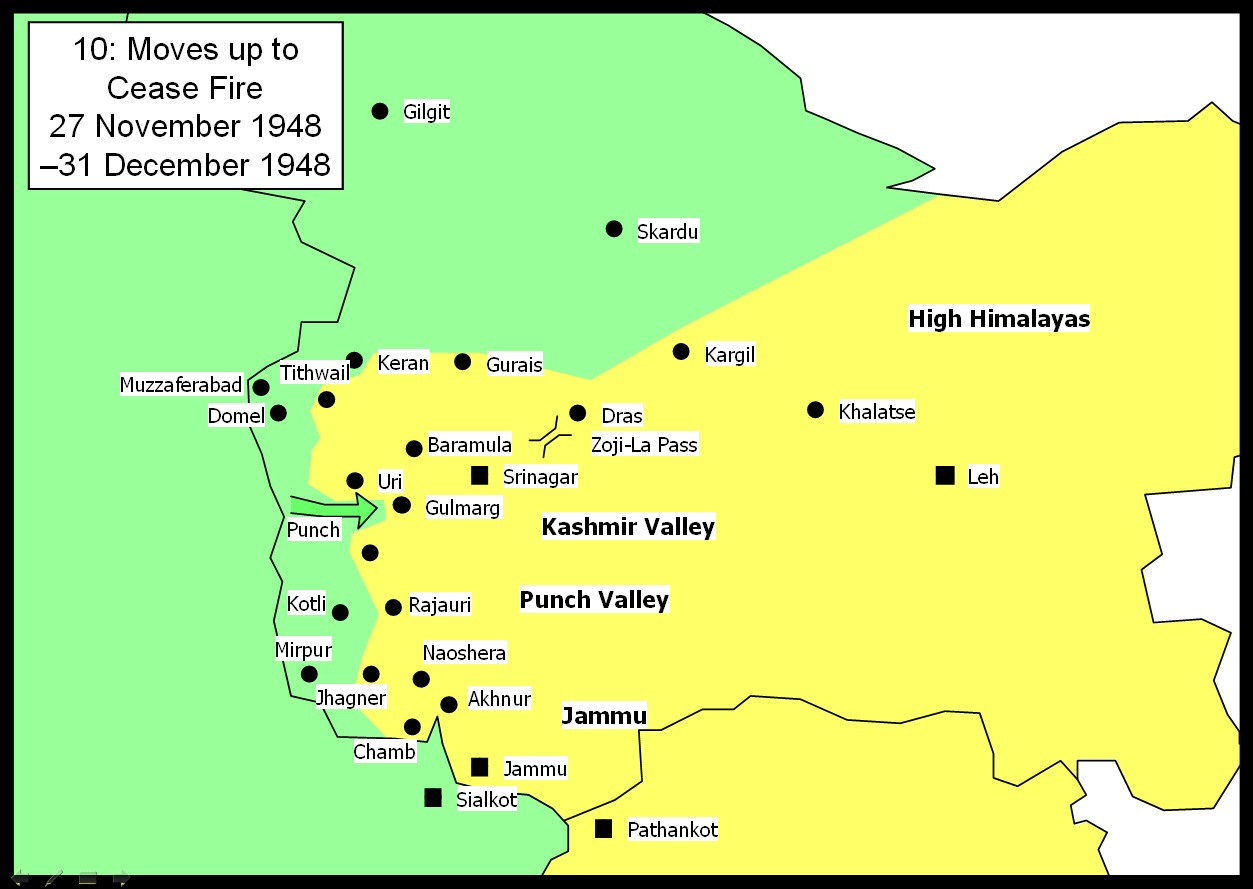Indo-Pakistani war of 1947–1948
| Indo-Pakistani War of 1947 | |||||||||
|---|---|---|---|---|---|---|---|---|---|
| Part of the Indo-Pakistani Wars | |||||||||
| File:1947 Indo Pak War.jpg Indian Army soldiers surround an enemy position | |||||||||
| |||||||||
| Belligerents | |||||||||
| India | Pakistan | ||||||||
| Casualties and losses | |||||||||
| 1,500 - 3,000 killed[1] | 1,500 - 5,000 killed[2] | ||||||||
The Indo-Pakistani War of 1947 sometimes known as the First Kashmir War was a war fought between India and Pakistan over the region of Kashmir from 1947 to 1949. It was the first of four wars fought among the two newly independent nations.
Cause
The state of Jammu and Kashmir was one of a number of Indian states that recognised British paramountcy. Prior to the withdrawal of the British from India, the state came under pressure from both India and Pakistan to join them. The Maharaja of Kashmir, Hari Singh wanted to remain independent and tried to delay the issue. However at the time of British withdrawal the state was invaded by a concentrated force of Pro-Pakistan Tribals from North West Frontier Province (NWFP) and regular Pakistani soldiers. This forced him to accede Kashmir to India who promptly rushed into Kashmir and thus the war had started. The accession is still questioned by the Pakistanis. The Pakistani claim is that since the majority of the Kashmiri population is Muslim, the princely state should have been given to Pakistan. The Indian claim arises from both Maharaja Hari Singh's accession, as had happened with all of the other Indian states, and also that 48% of Kashmir was Sikh, Buddhist and Hindu.
Summary of war
AZK (Azad Kashmir) forces (Azad in Urdu means liberated or free) are the local militia supported by the Pakistanis. The AZK had several advantages in the war, notably:
- Prior to the war the Jammu and Kashmir state forces had been spread thinly around the border as a response to militant activity, and so were badly deployed to counter a full scale invasion.
- Some of the state forces joined AZK forces.
- The AZK were also aided by regular Pakistani soldiers who manned some of their units, with the proportion increasing throughout the war.
- British officers may have helped the Pakistanis plan the attack. British officers on the scene lead the revolts of the Islamist factions of Kashmir forces, arresting and murdering Dogra officers especially in the Gilgit region. They acted as a backbone for the mass of tribal militias and coordinated their attacks.
As a result of these advantages the main invasion force quickly brushed aside the Jammu and Kashmir state forces. But the attacker’s advantage was not vigorously pressed and the Indians saved the country by airlifting reinforcements. This was at the price of the state formally acceding to India. With Indian reinforcements the Pakistani / AZK offensive ran out of steam towards the end of 1947. The exception to this was in the High Himalayas sector where the AZK were able to make substantial progress until turned back at the outskirts of Leh in late June 1948. Throughout 1948 many small-scale battles were fought. None of these gave a strategic advantage to either side and the fronts gradually solidified. Support for the AZK forces by Pakistan became gradually more overt with regular Pakistani units becoming involved. A formal cease-fire was declared on 31 December 1948.
Results of the war
Following the end of the war and the ceasefire India had managed to acquire two thirds of Kashmir while Pakistan had a third of the region. The Indians retained control of the relatively wealthy and populous Kashmir Valley, and a majority of the population. The number of casualties in the war are estimated to 2,000 for both sides. In 1957, this area became the state of Jammu and Kashmir in the India union. The cease fire line has over the years become a de facto division of the state.
Stages of the war
This war has been split into ten stages by time. The individual stages are detailed below.
Initial invasion 22 October 1947 – 26 October 1947 (Operation Gulmarg)
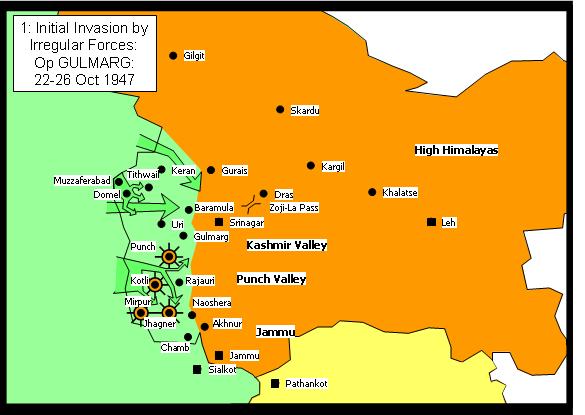
A large invasion of the Kashmir valley was mounted by the irregular forces, aimed at Srinagar, the capital of Jammu and Kashmir. The state forces were defeated and the way to the capital, (Srinagar), was open. There was also a mutiny by state forces in favour of the AZK in Domel.
In desperation, Hari Singh, the ruler of Kashmir requested the Indian Government for Indian troops to stop the uprising. The Indians told him that if Singh signed an Instrument of Accession allowing Kashmir to join the Indian Union, only then would India rush in troops for the protection of one of its territories. This, the Maharaja promptly did. Following this accession, the Indian troops arrived and quickly blocked the advance of the invaders, preventing the imminent sacking of Srinagar. Moreover, many of the irregular forces went home with their loot after plundering local towns and thus failed to press the attack home. In the Punch valley the Jammu and Kashmir state forces retreated into towns and were besieged.
Indian defence of the Kashmir Valley 27 October 1947 – 17 November 1947

Indian forces, rapidly airlifted to Srinagar managed to defeat the irregular forces on the outskirts of the town. This was partially due to an outflanking manoeuvre by armoured cars. Shattered, the AZK were pursued as far as Baramula and Uri and these towns were recaptured. In the Punch valley the sieges of the loyal Jammu and Kashmir state forces continued. Meanwhile, the troops in Gilgit (the Gilgit Scouts) mutinied and this yielded most of the far north of the state to the AZK. They were joined by the Forces of Chitral State, the Mehtar of Chitral had acceded to Pakistan and he sent his forces to fight alongside the Gilgitis because of the close cultural and historical ties between Chitral and Gilgit.
Attempted link-up at Punch 18 November 1947 – 26 November 1947
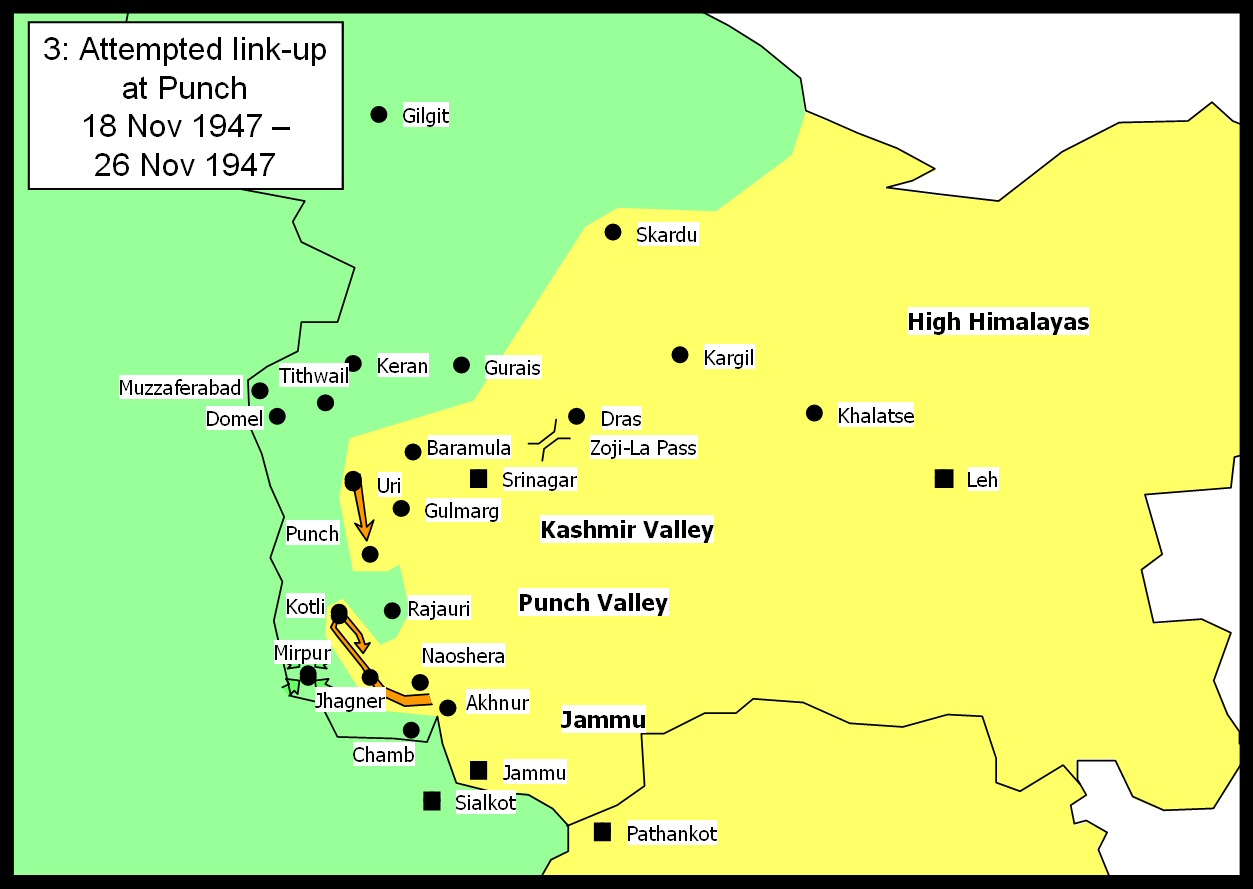
The Indian forces ceased their pursuit of the shattered AZK forces and swung south in an attempt to relieve Punch. This was less successful than hoped, because inadequate reconnaissance had underestimated the difficulty of the roads. Although the relief column eventually reached Punch, the siege could not be lifted. A second relief column reached only Kotli and was forced to evacuate its garrison. Mirpur was captured by the AZK and its inhabitants particularly the Hindus were slaughtered.
Fall of Jhanger and attacks on Naoshera and Uri 25 November 1947 - 6 February 1948

The Pakistani/AZK forces attacked and captured Jhanger. They then attacked Naoshera successfully. Other Pakistani/AZK forces made a series of unsuccessful attacks on Uri. In the south a minor Indian attack secured Chamb. By this stage of the war the front line began to stabilise as more Indian troops became available.
Op Vijay: counterattack to Jhanger 7 February 1948 - 1 May 1948
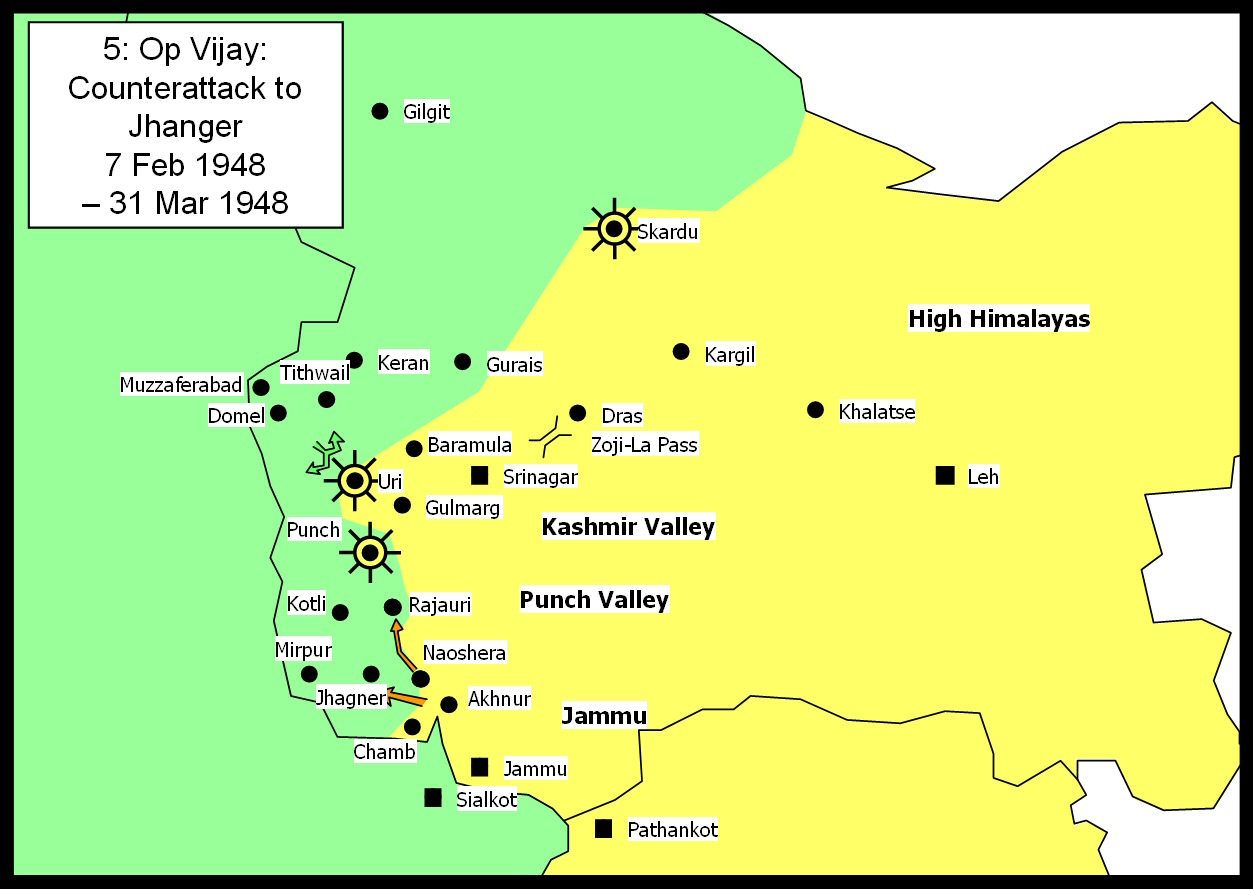
The Indian forces launched a counterattack in the south recapturing Jhanger and Rajauri. In the Kashmir Valley the Pakistani/AZK forces continued attacking the Uri garrison. In the north Skardu was brought under siege by Pakistani/AZK forces.
Indian Spring Offensive 1 May 1948 - 19 May 1948

The Indians held onto Jhanger against numerous counterattacks from the AZK, who were increasingly supported by regular Pakistani Forces. In the Kashmir Valley the Indians attacked, recapturing Tithwail. The AZK made good progress in the High Himalayas sector, infiltrating troops to bring Leh under siege, capturing Kargil and defeating a relief column heading for Skardu.
Operations Gulab and Erase 19 May 1948 - 14 August 1948
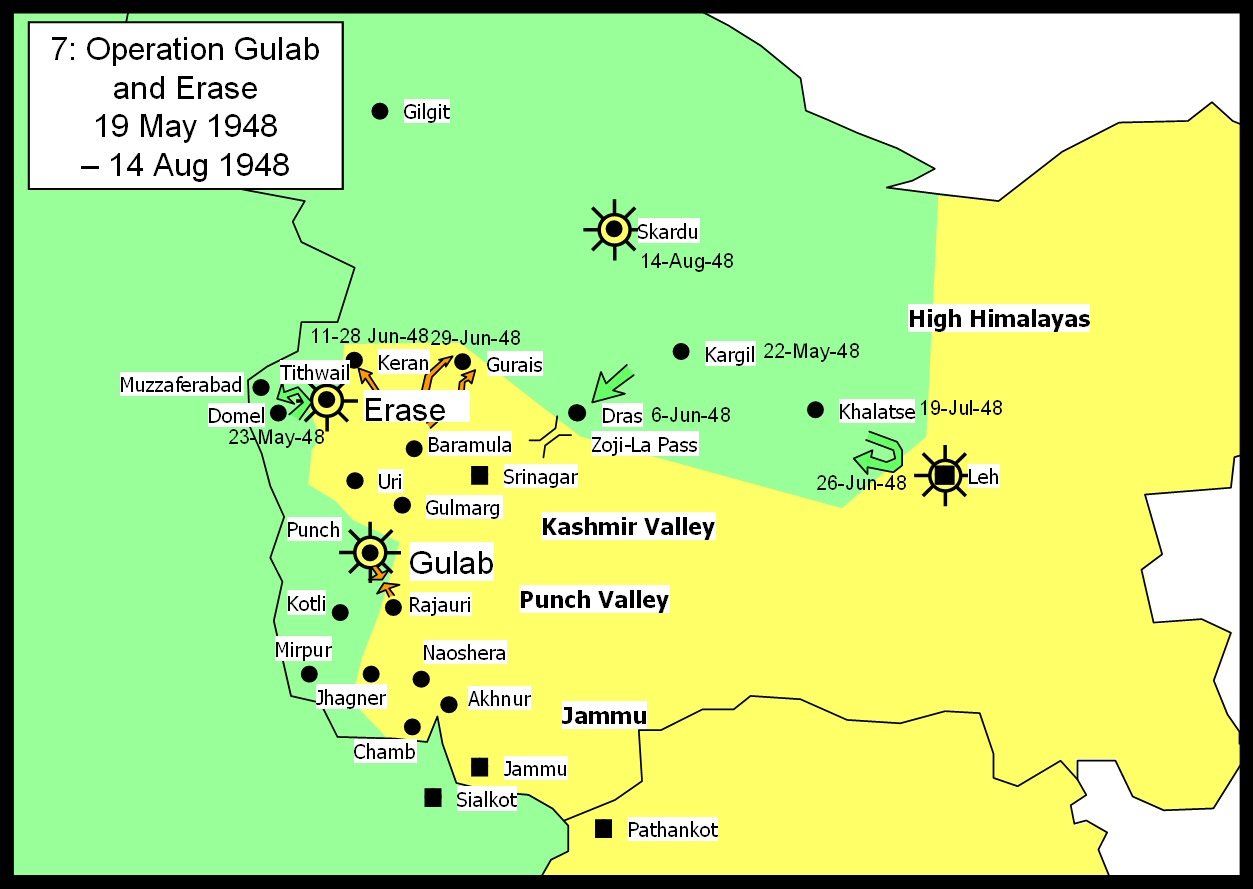
The Indians continued to attack in the Kashmir Valley sector driving north to capture Keran and Gurais. They also repelled a counterattack aimed at Tithwail. In the Punch Valley the forces besieged in Punch broke out and temporarily linked up with the outside world again. The Kashmir State army was able to defend Skardu from the Gilgit Scouts and thus they were not able to proceed down the Indus valley towards Leh. In August the Chitral Forces under Mata-ul-Mulk besieged Skardu and with the help of artillery were able to take Skardu. This freed the Gilgit Scouts to push further into Ladakh.
Operation Duck 15 August 1948 - 1 November 1948
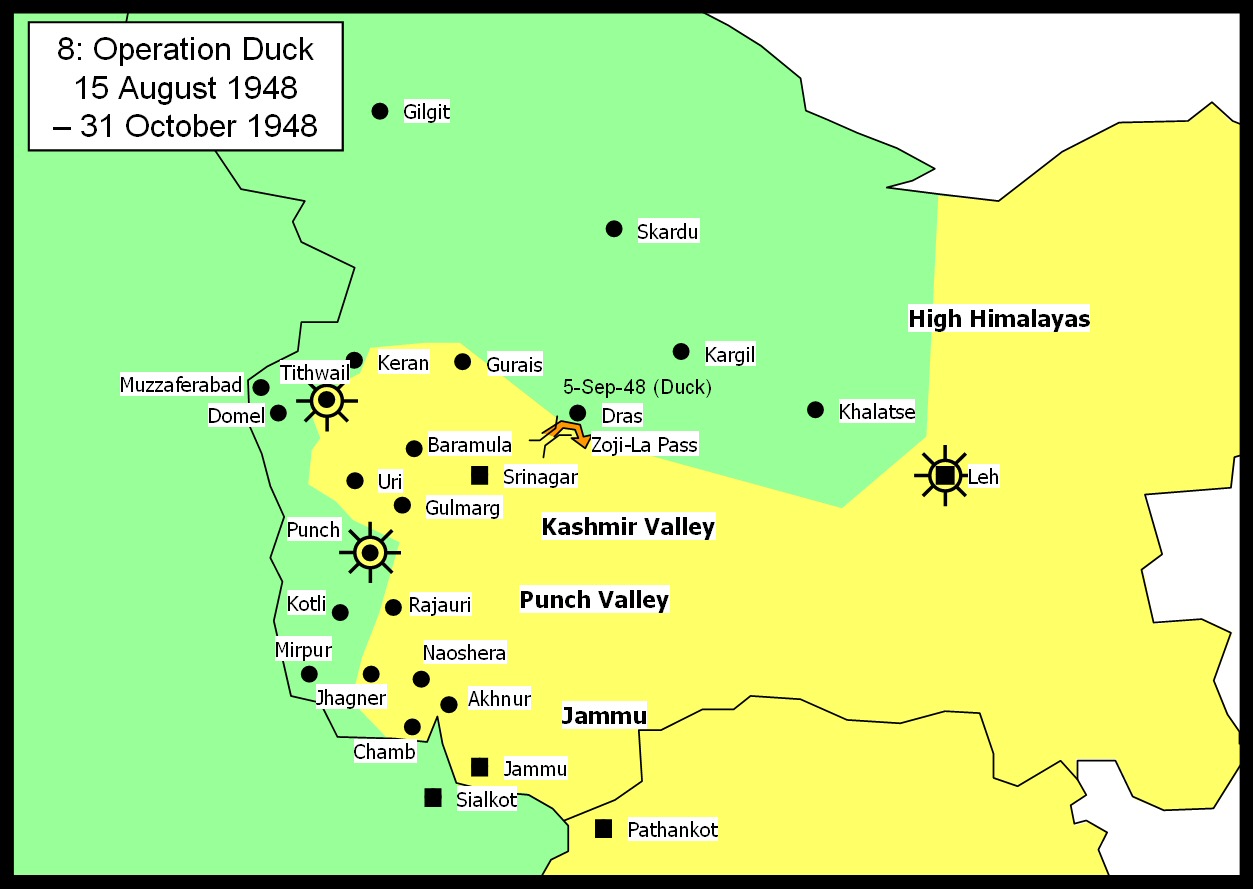
During this time the front began to settle down with less activity by either side, the only major event was an unsuccessful attack by the Indians towards Dras (Operation Duck). The siege of Punch continued.
Operation Easy. Punch link-up 1 November 1948 - 26 November 1948
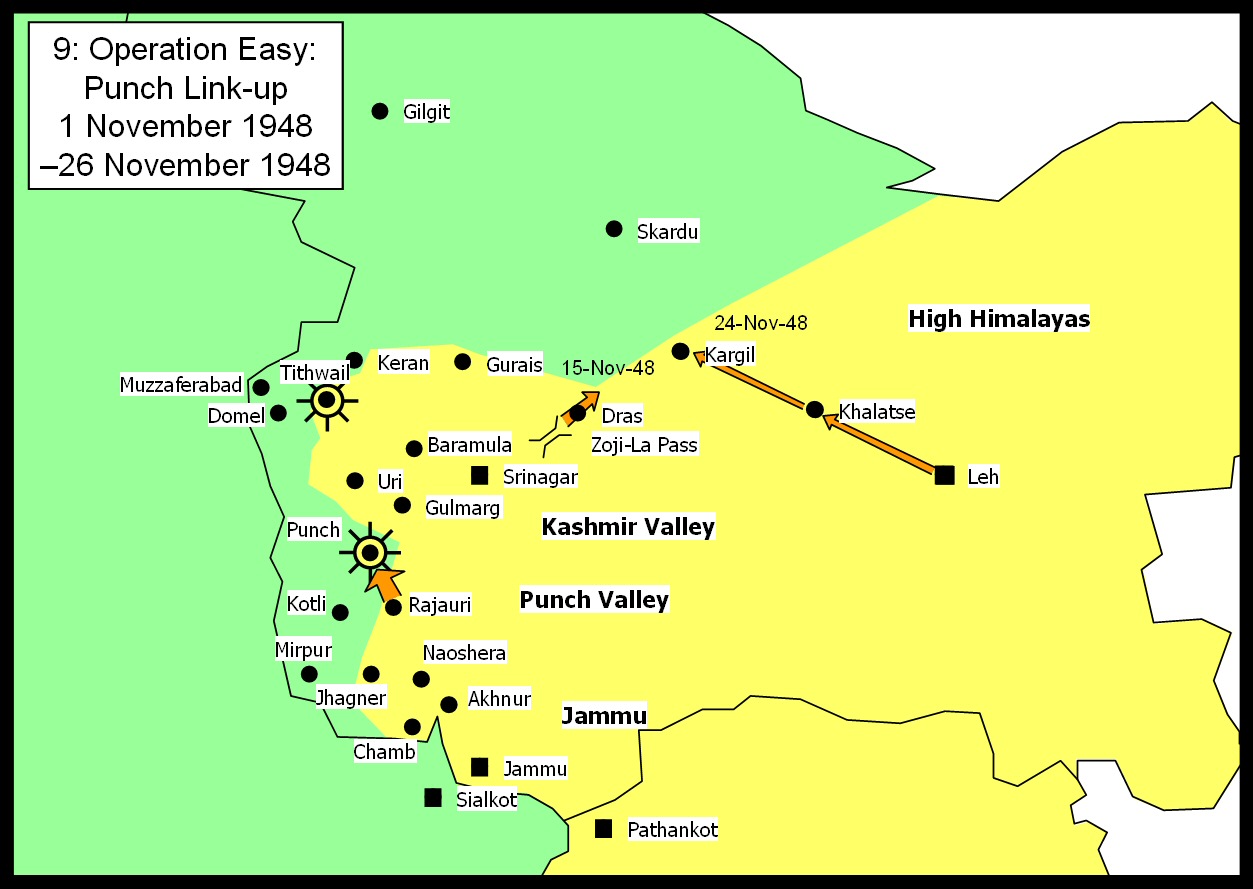
The Indians now started to get the upper hand in all sectors. Punch was finally relieved after a siege of over a year. The Gilgit forces in the High Himalayas, who had previously made good progress, were finally defeated. The Indians pursued as far as Kargil before being forced to halt due to supply problems. The Zoji-La pass was forced by using tanks (which had not been thought possible at that altitude) and Dras was recaptured. The use of tanks was based on experience gained in Burma in 1945.
Moves up to cease-fire. 27 November 1948 - 31 December 1948
Realizing that they were not going to make any further progress in any sector, the Pakistanis decided to end the war. A UN cease-fire was arranged for the 31 December 1948. A few days before the cease-fire the Pakistanis launched a counter attack, which cut the road between Uri and Punch. After protracted negotiations a cease-fire was agreed to by both countries, which came into effect. The terms of the cease-fire as laid out in the UNCIP resolution.[3] of August 13 1948 were adopted by the UN on January 5 1949. This required Pakistan to withdraw its forces, both regular and irregular, while allowing India to maintain minimum strength of its forces in the state to preserve law and order. On compliance of these conditions a plebiscite was to be held to determine the future of the territory. In all, 1,500 soldiers died on each side during the war[4] and Pakistan was able to acquire roughly two-fifths of Kashmir while India acquired the majority of Kashmir, including the most populous and fertile regions.
Military insights gained from the war.
On the use of armour
The use of light tanks and armoured cars was important at two stages of the war. Both of these Indian victories involved very small numbers of AFVs. These were:-
- The defeat of the initial thrust at Srinagar, which was aided by the arrival of 2 armoured cars in the rear of the irregular forces.
- The forcing of the Zoji-La pass with 11 Stuart M5 light tanks.
This may show that armour can have a significant psychological impact if it turns up at places thought of as impossible. It is also likely that the invaders did not deploy anti-tank weapons to counter these threats. Even the lightest weapons will significantly encumber leg infantry units, so they may well have been perceived as not worth the effort of carrying about, and left in rear areas. This will greatly enhance the psychological impact of the armour when it does appear. The successful use of armour in this campaign strongly influenced Indian tactics in the 1962 war where great efforts were made to deploy armour to inhospitable regions (although this method failed miserably in 1962).
Progression of front lines
- It is interesting to chart the progress of the front lines. After a certain troop density is reached progress was very slow with victories being counted in the capture of individual villages or peaks. Where troop density was lower (as it was in the High Himalayas sector and at the start of the war) rates of advance can be very high.
Deployment of forces
- The Jammu and Kashmir state forces were spread out in small packets along the frontier to deal with militant incidents. This made them very vulnerable to a conventional attack. India used this tactic successfully against the Pakistan Army in East Pakistan (present day Bangladesh) in the 1971 war.
Notes
References
Major sources
- “Operations In Jammu and Kashmir 1947-1948” Ministry of Defence, Government of India, Thomson Press (India) Limited. New Delhi 1987. This is the Indian Official History, and was the major source for this work.
- “The Indian Army After Independence”, by KC Praval, 1993. Lancer International, ISBN 1-897829-45-0
- “Slender Was The Thread: The Kashmir confrontation 1947-1948”, by Maj Gen LP Sen, 1969. Orient Longmans Ltd New Delhi.
- “Without Baggage: A personal account of the Jammu and Kashmir Operations 1947-1949” Lt Gen. E. A. Vas. 1987. Natraj Publishers Dehradun. ISBN 81-85019-09-6.
Other sources
- “The Indian Armour: History Of The Indian Armoured Corps 1941-1971”, by Maj Gen Gurcharn Sandu, 1987, Vision Books Private Limited, New Delhi, ISBN 81-7094-004-4.
- “Thunder over Kashmir”, by Lt Col Maurice Cohen. 1955 Orient Longman Ltd. Hyderabad
- “Battle of Zoji La”, by Brig Gen SR Hinds, Military Digest, New Delhi, 1962.
- “History of Jammu and Kashmir Rifles (1820-1956)”, by Maj K Barhma Singh, Lancer International New Dehli, 1990, ISBN 81-7062-091-0.

